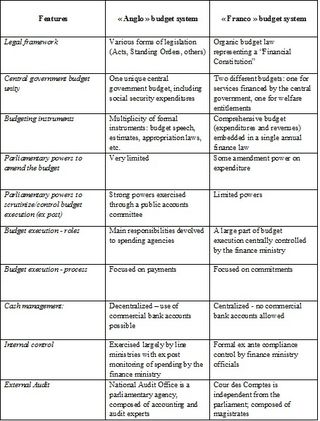Posted by Benoit Chevauchez
PFM experts will be familiar with the “anglo-franco derby” of budget systems. Many countries follow the so-called anglo-saxon model – as termed by the French - while others follow the francophone model. Most PFM experts have some implicit preference for one or other of these models, which more broadly reflect the British/Westiminster and French traditions of public administration. What are the realities at stake behind this friendly competition?
It should be noted that many variants and sub-families of the Westminster and French budget systems exist. For example: Rwanda, Burundi and the Democratic Republic of Congo belong to the Belgium group of PFM systems, which is slightly different from the French model; and the systems of Australia and New-Zealand, albeit belonging to the Westminster family, have some specific characteristics.
It should also be recognized that the anglo and franco budgetary models share some important common features. They both belong to the family of unitary states as opposed to the federal model of PFM (Germany, Austria, the U.S. and to some extent Spain) and Scandinavian/municipal models. They also both belong to a parliamentarian system of governance dating back many centuries, as opposed to a congressional system. But beyond these basic common features, there are many differences between the two models, as illustrated in the table below. Note that the table does not present a full description of the two models, and has been simplified and stylized to some extent.

During the last two decades, there has been some convergence between the anglo and franco models. Thus, the French budget system has moved toward more managerial delegation, and the tradition of strong centralized control of day-to-day operations by the finance ministry is losing ground. Moreover, the emphasis given to ex ante compliance control is being progressively replaced by ex post internal audit. Similarly, some Westminster systems are now adopting TSA (Treasury Single Account) arrangements similar to the traditional French-style CUT (Compte Unique du Trésor), and are increasingly adopting the French use of commitments as a basis for control.
The process of convergence has been reinforced by the development of new concepts of budgeting that have been adopted by many countries of both the anglo and franco tradition. These developments include program budgeting, multiyear budgeting and accrual accounting. In such areas, the pace of reform varies from country to country, and the details differ, but the conceptual framework and the general direction of change are the same in the two systems.
This trend toward convergence is likely to continue in the coming years. The drivers of change are many: globalization is an important factor, even in the very technical area of PFM. International standards (GFS, IPSAS, INTOSAI, etc.) also play a role. Technical assistance, benchmarking practices and the development of IT software systems push in the same direction. However, the move toward convergence has been slow and traditional factors and values such as culture, institutions, and politics continue to exercise a powerful influence on budgeting practices. It is therefore unlikely that a single universal PFM model will emerge in the long term.
In addition to these two well known budget systems, other models of budgeting exist. There is the Nordic model (Sweden, Norway, Denmark, Finland, Iceland) whose main feature is strong municipalities combined with a high public spending /GDP ratio; the Germanic model (Germany, Austria), characterized by strongly developed fiscal federalism and a Bismarkian welfare system; and the Iberian model (Spain, Portugal, Latin America) which can be divided into its Spanish and Portuguese variants. One might also speculate about the existence of an Ottoman model (Turkey plus some Middle-Eastern and Central Asian countries), a Soviet model (Russia and ex Soviet republics) and possibly even an Arabic model. In some countries – China for example – little is known about the existing PFM model. What are its main features? Are some elements shared with neighboring countries in Asia?
Developing a budget system taxonomy might be an interesting new field for exploration and discussion. How should the budget system of a given country be characterized and classified? To which family or sub-family of PFM systems does the country belong? As with any such taxonomy, whether it is applied to butterflies, paintings or PFM systems, the most critical issue is to define relevant classification criteria. Implicitly, this article assumes that the historical and cultural environment of a country is an important factor in developing the taxonomy. This assumption may prove wrong. It might be wiser to identify more tangible criteria such as the degree of centralization or decentralization of the budget process, the type and strength of political institutions, the size of the government, the degree of fragmentation of the PFM system, and so on.
Beyond the somewhat academic interst of a PFM taxonomy, the approach described above could help shed new light on budget functions and institutions, clarify international comparisons and better match TA expertise to different countries. It would also be a useful complement to existing PFM assessment tools such as PEFA and the IMF’s new Fiscal Transparency Evaluation (FTE) instrument.
Note: The posts on the IMF PFM Blog should not be reported as representing the views of the IMF. The views expressed are those of the authors and do not necessarily represent those of the IMF or IMF policy.






